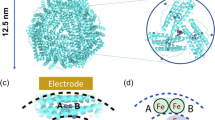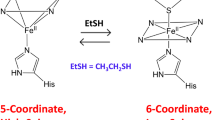Abstract
The ferritin of Escherichia coli (EcFtnA) is similar to human H-chain ferritin (HuHF) in having 24 subunits, each containing a dinuclear site at which two iron atoms can be oxidised (the diiron centre). In EcFtnA, unlike HuHF, fluorescence quenching of Trp122, located near site A of the dinuclear centre, can be used to monitor metal binding (this tryptophan is absent from HuHF). Metal binding also perturbs the UV absorbance spectrum of Trp122 and that of Tyr24 (a conserved residue near site B of the dinuclear centre). Using UV-difference spectroscopy and fluorescence quenching it is shown that Fe(II) and Zn(II) bind at the same sites, A and B. Sequential stopped-flow studies of Fe(II) binding and oxidation also show that Zn(II) is an effective competitor of Fe(II) binding and an inhibitor of its oxidation.
Similar content being viewed by others
Author information
Authors and Affiliations
Additional information
Received: 10 June 1998 / Accepted: 18 September 1998
Rights and permissions
About this article
Cite this article
Treffry, A., Zhao, Z., Quail, M. et al. The use of zinc(II) to probe iron binding and oxidation by the ferritin (EcFtnA) of Escherichia coli . JBIC 3, 682–688 (1998). https://doi.org/10.1007/s007750050282
Issue Date:
DOI: https://doi.org/10.1007/s007750050282




